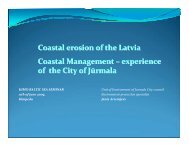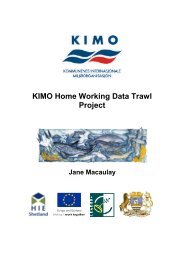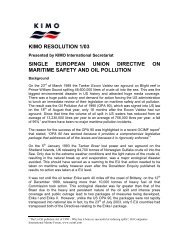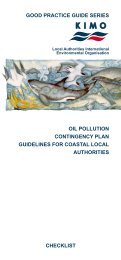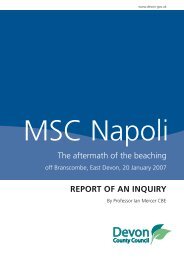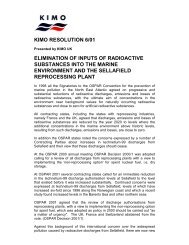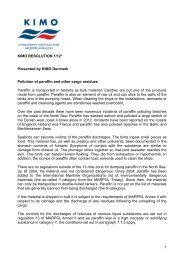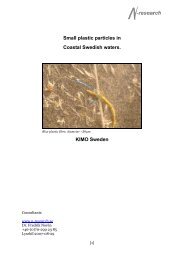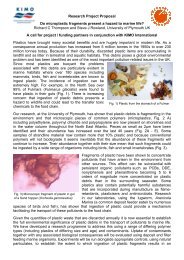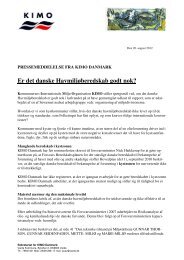Robert Ashdown, Chamber of Shipping - KIMO
Robert Ashdown, Chamber of Shipping - KIMO
Robert Ashdown, Chamber of Shipping - KIMO
- No tags were found...
Create successful ePaper yourself
Turn your PDF publications into a flip-book with our unique Google optimized e-Paper software.
An overview <strong>of</strong> existing and forthcoming environmentallegislation governing international shipping<strong>KIMO</strong> UK Conference, Inverness18 June 2010ROBERT ASHDOWNHead <strong>of</strong> TechnicalUK <strong>Chamber</strong> Of <strong>Shipping</strong>
Today’s s Presentation• A little bit about the <strong>Chamber</strong>• The nature and scope <strong>of</strong> current environmentalregulations• How the <strong>Chamber</strong> develops environmental policy• A couple <strong>of</strong> case studies – 1) Air Pollution 2) Carbon• How to approach future environmental legislation
The UK <strong>Chamber</strong> <strong>of</strong> <strong>Shipping</strong>139 Members932 ships <strong>of</strong> 25m gt95% <strong>of</strong> UK tonnageRecognised as the voice <strong>of</strong>UK <strong>Shipping</strong>Work closely with ICS &ECSA
Two Broad Types Of EnvironmentalLegislation1. Environmental performance <strong>of</strong> ships– Focused around the ship and subsequent compliance2. <strong>Shipping</strong> operations in the marine environment– Focused around shipping’s contribution to broaderenvironmental objectives
Environmental legislationExplosion in environmental legislation in recent years21 <strong>of</strong> the IMO’s 51 conventions relate to the environment• MARPOL & Annexes I – VI• Anti-fouling Convention• Hazardous & Noxious Substances (HNS)• Ballast Water• Ship RecyclingIn addition to this there are numerous local, national, and regionalenvironmental regulations that affect international shipping
Environmental CoverageVirtually all sources <strong>of</strong> shipping pollution are regulated:• Discharges to sea:• Ballast Water• Sewage• Garbage• Discharges to Air:• SOx, NOx, PM• Protective Measures for accidents:• Oil (cargo and bunkers)• Hazardous Substances• Associated liability conventions
Remaining Gaps Bio–fouling Underwater Noise CARBONWork on the above is ongoing while existing regulations constantlyunder reviewE.g. MARPOL Annex V – Garbage: move to presumption <strong>of</strong> nooverboard dischargesTruly a cradle (EEDI) to grave (ship recycling)regulatory regime
The <strong>Chamber</strong> & the Environment• Standing item on Board Agenda• Environment Committee Chairman has seat on Board• One Stop Shop – all issues covered• Bold & Progressive Environmental Statement• Ahead <strong>of</strong> the ‘environmental curve’• <strong>Chamber</strong> Members will always meet or beat environmental legislation• Trials <strong>of</strong> Scrubbers & Other Technologies• Marine Planning/Conservation (employ our own oceanographer)• GHG Emissions• Good position to influence debate at ICS and ECSA
CoS Environmental StatementThe <strong>Chamber</strong> <strong>of</strong> <strong>Shipping</strong> is committed to sustainable shipping and to the protection and conservation <strong>of</strong> the environment. The <strong>Chamber</strong>will encourage its members to operate as follows:– Include environmental concerns on an equal basis with economic and commercial considerations in decision-making.– Identify the environmental impacts <strong>of</strong> their operations and to take the appropriate steps to minimise or eliminate those impacts in asimilar manner to health & safety risk assessments.– Go beyond legal compliance by subscribing to relevant industry best practice and by encouraging all staff to take voluntary steps toimprove environmental performance.– Establish pre-defined objectives or targets to help achieve their environmental aspirations.– Monitor their environmental performance, to seek continuous improvement, to conduct regular reviews, and to verify progresstowards meeting their environmental objectives.– Ensure that management at senior manager or board level takes ownership <strong>of</strong> environmental issues and develop good communicationflows to foster a sense <strong>of</strong> environmental responsibility in every employee.– Make available the appropriate resources and provide the necessary training for employees to comply with, and where appropriateexceed, their statutory environmental obligations.– Encourage the development and installation <strong>of</strong> new Shipboard Systems and/or procedures to reduce environmental impact.– Encourage the use <strong>of</strong> recyclable materials whenever possible, to minimise packaging and to dispose <strong>of</strong> waste in an environmentallyresponsible manner.– Encourage contractors and suppliers to apply these principles and, if necessary, require them to improve their standards to conformwith the above.In addition to the high-level objectives contained within this statement, the <strong>Chamber</strong> <strong>of</strong> <strong>Shipping</strong> will work with other organisations to findsolutions to environmental problems and to engage actively in promoting the environmental agenda on the international stage.The <strong>Chamber</strong> will communicate its environmental statement to its members, the UK and other governments, Maritime Administrations, EU,IMO and the public, thereby confirming its commitment to sustainable shipping and to the protection and conservation <strong>of</strong> the environment.
Two Case Studies• Revised MARPOL Annex VI (SOx, NOx, PM)• CarbonAlthough both related to emissions to air and <strong>of</strong>ten confusedthese are best treated as separate items
0.1% in ECAsThe Problem• Essentially requires a distillate fuel• Doubling <strong>of</strong> costs for operators overnight• One compliance option (scrubbers don’t work)• Will lead to closure <strong>of</strong> longer distance short sea routes• Negative modal shift meaning net environmental benefit isquestionableThe Solution• Likely that reduction to 0.5% fuel will achieve c90% <strong>of</strong> humanhealth/environmental benefits at much lower cost• Modal shift much less likely• 0.5% links neatly with future global requirements and willhelp stimulate future demand for global low sulphur fuel
IMO Programme For Carbon ReductionCurrent state <strong>of</strong> play:• IMO the responsible body for addressing GHGs underKyoto• IMO badly inhibited by contradictory principles• COP15 <strong>of</strong>fered no help on CBDR/NMFT or targets• IMO therefore continuing to work in a semi-detached way• Three strands to be brought together by Dec 2011EEDIEEOI/SEEMPMBMsNot industry but Member States holding back progress
Industry Parameters For Any MBM• IMO the competent authority• MBI global and flag-blind• Early decision needed to avoid regional action• Use Bunker Delivery Notes to confirm emissions• Some revenues recycled back into industry inR&D• Revenue from shipping tradable with existingcarbon reduction schemes, eg CDMs/Jis• Use <strong>of</strong> existing shipping procedures wherepossible
General Industry PositionInternational <strong>Shipping</strong>• Commitment to reduce carbon impact• <strong>Shipping</strong> – irreplaceable engine <strong>of</strong> world trade• <strong>Shipping</strong> – greenest transport mode• Strive to improve fuel efficiency• Supports 9 fundamental principles from MEPC 57BUT WITHOUT AN MBM THIS MAY NOT BE ENOUGHUK <strong>Chamber</strong>• Supports the above and:• MBIs both inevitable and desirable• Clear preference for global, open trading system
Why trading is <strong>Chamber</strong>’spreferred market solution• Certainty <strong>of</strong> environmental outcome• Most effective method <strong>of</strong> establishing true price<strong>of</strong> carbon• Allows market to identify most cost-effectivemeans <strong>of</strong> reducing emissions• Fits with existing & likely future developments
www.british-shipping.org/publications
Possible Future Developments• IMO delivers robust package <strong>of</strong> measures sufficient tomeet global requirements• International shipping included in a post-Kyoto regimeunder authority <strong>of</strong> UNFCCC• <strong>Shipping</strong> treated as a cash cow for ‘innovative’ globalfinancing - $100 billion by 2020• Lack <strong>of</strong> global agreement leads to proliferation <strong>of</strong>regional / national schemes (EU, US, Aus, NZ, Japan)• CO2 emissions from shipping remains unregulatedPreference
Why Environmental RegulationsRequire A Different Approach• The scale <strong>of</strong> shipping’s contribution is <strong>of</strong>tenover/under estimated• Politics overrides the need for evidence• The solution may be worse than the problem• ‘Solutions’ imposed reliant on non-existent technology
What Does Industry Want FromEnvironmental Regulation• Environmental legislation to be developed on soundscience and with cost/benefit analysis• Protect what it needs to protect• Face standards similar to those <strong>of</strong> land-basedregulations• Regs should be goal based and have multiplecompliance options• No assumption that regulation will lead the technologyMeasurable improvement in environmental standards
<strong>Robert</strong> <strong>Ashdown</strong>Head <strong>of</strong> Technical<strong>Chamber</strong> <strong>of</strong> <strong>Shipping</strong>+44 (0) 207 417 2819+44 (0) 7738 009 230<strong>Robert</strong>.ashdown@british-shipping.org



